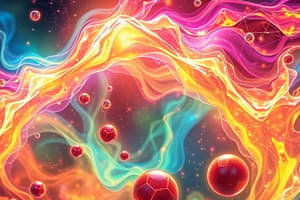Podcast
Questions and Answers
What is the structure of aluminum chloride (AlCl₃)?
What is the structure of aluminum chloride (AlCl₃)?
- Network
- Tetrahedral (correct)
- Linear
- Crystalline lattice
Which compound has a more complex structure, potassium fluoride (KF) or calcium fluoride (CaF₂)?
Which compound has a more complex structure, potassium fluoride (KF) or calcium fluoride (CaF₂)?
- Both have similar structures
- CaF₂ (correct)
- Neither, they have simple structures
- KF
Which metal is essential in blood-oxygen transport and steel construction?
Which metal is essential in blood-oxygen transport and steel construction?
- Zinc
- Aluminum
- Silicon
- Iron (correct)
In which of the following is silicon commonly used?
In which of the following is silicon commonly used?
What is the role of copper in everyday applications?
What is the role of copper in everyday applications?
Which technology relies on lithium-ion batteries powered by lithium compounds?
Which technology relies on lithium-ion batteries powered by lithium compounds?
Which type of elements can be found in inorganic compounds?
Which type of elements can be found in inorganic compounds?
What type of bond is formed between sodium and chlorine in the compound NaCl?
What type of bond is formed between sodium and chlorine in the compound NaCl?
Which element forms a coordinate covalent bond with another element?
Which element forms a coordinate covalent bond with another element?
What compound is produced when aluminum reacts with oxygen?
What compound is produced when aluminum reacts with oxygen?
Which of the following elements is a metalloid?
Which of the following elements is a metalloid?
What compound is produced when hydrogen combines with oxygen?
What compound is produced when hydrogen combines with oxygen?
Study Notes
Discovering the Wonders of Inorganic Chemistry
Inorganic chemistry is a captivating branch of chemistry that explores the properties, reactions, and compounds of elements that don't contain carbon in their chemical structures. From the iron in your blood to the aluminum in your phone, inorganic chemistry underpins much of our daily lives. To dive into this fascinating world, let's explore some of its key aspects.
Elements and Compounds
Inorganic compounds are formed from elements, which can be divided into three main groups: metals, non-metals, and metalloids. Metals include elements like aluminum, iron, and lead, while non-metals include elements like hydrogen, oxygen, and chlorine. Metalloids, like silicon and germanium, have properties that lie between metals and non-metals.
Inorganic compounds, such as oxides, sulfides, and chlorides, are formed through chemical reactions between these elements. For instance, when hydrogen combines with oxygen, water (H2O) forms. Sodium and chlorine, when combined, produce sodium chloride (NaCl) — table salt.
Bonding and Structure
Inorganic compounds can form various types of chemical bonds, including ionic, covalent, and coordinate covalent bonds. For example, sodium and chlorine form an ionic bond, where sodium loses an electron to become a positively-charged ion (Na⁺), and chlorine gains an electron to become a negatively-charged ion (Cl⁻). These oppositely charged ions attract each other, leading to the formation of NaCl.
The structure of inorganic compounds can vary from simple linear or tetrahedral arrangements to complex crystal lattices or networks. For instance, the simple compound aluminum chloride (AlCl₃) has a tetrahedral structure, where each aluminum atom is surrounded by four chlorine atoms. Compounds like potassium fluoride (KF) and calcium fluoride (CaF₂) have more complex structures, forming crystalline lattices.
Applications
Inorganic chemistry underpins a vast array of applications, from simple everyday items to cutting-edge technologies. For instance, iron-based compounds are essential in our lives, from steel construction to blood-oxygen transport in the human body. Other common applications include:
- Aluminum: Used in construction, transportation, and packaging.
- Silicon: Used in electronics and solar cells.
- Zinc: Used in batteries, coatings, and galvanization.
- Lead: Used in batteries, radiation shielding, and ammunition.
- Copper: Used in electrical wiring, plumbing, and electronics.
Inorganic chemistry also plays a crucial role in modern technologies like semiconductors, solar cells, and batteries. For example, lithium-ion batteries, which power many of our electronic devices, use lithium and various compounds of aluminum, carbon, and phosphorus.
Inorganic chemistry is a vast, fascinating, and ever-evolving field that continues to bring us new materials and technologies. As you explore this topic, you'll discover its unique potential and the many ways it contributes to our lives!
Studying That Suits You
Use AI to generate personalized quizzes and flashcards to suit your learning preferences.
Description
Test your knowledge on the fundamental aspects of inorganic chemistry, from elements and compounds to bonding and applications. Explore the captivating world of inorganic chemistry through this quiz!



